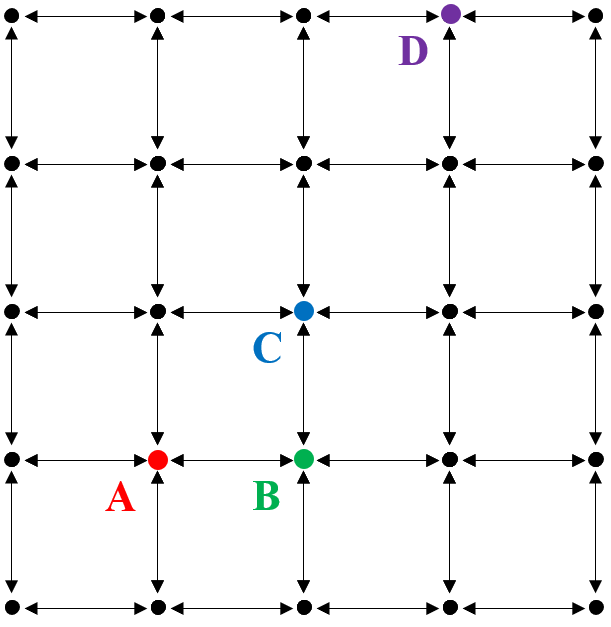In collaboration with Johan-Tobias Schäg, we were able to create a rule producing an ordinary 2D-grid (https://community.wolfram.com/groups/-/m/t/1946413). Wolfram himself also mentions grids several times (see for example: https://www.wolframphysics.org/technical-introduction/limiting-behavior-and-emergent-geometry/recognizable-geometry/). It is often assumed in several of the texts I read on this subject (the last link is an example) that in the limit of making grids finer and finer we obtain the well known 2-dimensional continuous space. This is not correct, however. In fact, it seems quite complicated to come up with a graph structure that resembles classical 2D-space even remotely (the same is true for higher dimensions as well).
It is important to solve this problem since any model resembling physics should look like ordinary continuous space on large scales.
In order to illustrate this, I will consider the simplest case known to us all; the regular 2D-grid (see the figure below). I have drawn a piece of a 2D-grid, as well as four points on the grid labeled A, B, C, and D.

In the texts, I have read so far, there is no mention of how we think about distances in graphs. However, there are indirect hints. For example, when the subject of dimension and curvature is discussed, the distance $r$ from a point plays a crucial role. In these cases, the distance between two vertices is indirectly defined as the least number of (hyper)edges you would have to cross in order to get from one point to the other. This is a very logical definition, and I will keep using it here.
Now keep in mind, that the graphs we draw do not illustrate these distances correctly. They are only representations of the graph. For example, take another look at the picture of the grid above. The distance between A and B is 1 (you could call one edge for the fundamental length unit, or you could simply omit units for simplicity) and the distance between A and D is 5. The distance between B and C is also 1. However, as the graph is drawn on this picture, the distance between A and C should be $\sqrt{2}$, while the true answer is that the distance is 2! In fact, you could never create graphs with non-integer distances.
Okay, this is weird, but not problematic yet. After all, the graph should only look like ordinary space on large scales, and my example here is on the absolutely smallest scale possible. However, even on large scales, the answer is still the same. Imagine a huge grid with point A. Choose a direction and go $n$ steps in only that direction (left, right, up, and down are the possibilities on a grid). Now denote the point you end up at by B. There is no shorter path between the two points, which means that the distance between A and B is $n$. Now choose a new direction away from B, which is not the same (or opposite) as before. If you chose to go to the right away from A, you could choose to go upward now, for example. Go another $n$ steps up and label this point C. We are now in the same case as before, but by varying $n$ we can vary the scale of the setup as much as we want.
What is the distance between A and C? One path to take is to go from A to B and then from B to C as above. In fact, there is no shorter path than this either! So the distance is $2n$.
In the usual 2D-space, we expect the ratio between the distance from A til B (denoted $d(A,B)$) and from A til C to fulfill the following identity: $$\frac{d(A,C)}{d(A,B)}=\sqrt{2}$$ A non-integer value like this is no problem anymore (irrational numbers are, however, but never mind that for now). What is the case for our graph? Well, that is easily calculated: $$\frac{d(A,C)}{d(A,B)}=\frac{2n}{n}=2$$ The result is 2 no matter how huge $n$ is! You can make the grid as fine as you ever want it, but you will never get to the usual 2D-space. You could also say that the Pythagorean Theorem doesn't apply, which we know it has to in any physical space. The same problem arises for any regular grid.
There are two main points up until now: 1) do not believe in the distances drawn on a graph (even simple, regular ones), and 2) just because you get an infinitely fine grid, you do not automatically get continuous space.
All is not lost, however. Up until now, I have only mentioned regular grids. It is, however, not surprising if nature is not regular on the smallest of scales. In fact, I would be very surprised if that was really the case. Instead, a graph that appears 2-dimensional on large scales could very well look quite chaotic on the small scales. The vertices and edges could have very complicated and seemingly random connections (I have heard rumors of Wolfram mentioning this, but I am not sure). This could solve the problem, but the natural question then is this:
How do we create a grid which obeys the Pythagorean Theorem on large scales?
Other natural questions to ask are:
How do we deal with angles on large scales? How and when are they defined?
What happens to the irrational numbers that arise from the Pythagorean Theorem? Are they approximations?
Can we create a large scale isotropic graph?